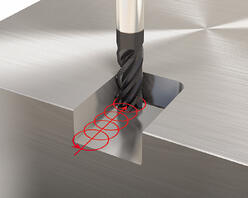Why You Should Consider Trochoidal Milling
 As defined by tool supplier Sandvik Coromant, trochoidal milling is “…circular milling that includes simultaneous forward movements. The cutter removes repeated slices of material in a sequence of continuous spiral tool paths in its radial direction.”
As defined by tool supplier Sandvik Coromant, trochoidal milling is “…circular milling that includes simultaneous forward movements. The cutter removes repeated slices of material in a sequence of continuous spiral tool paths in its radial direction.”
This CNC milling method is considered an excellent solution for difficult CNC machining situations including slotting of hardened and exotic materials such as Inconel or Titanium, and other materials where the slot is wider than the tool diameter. It also has application for milling deep pockets and grooves, and in confined cavities.
Gosiger 3-D Application Engineer, Brian Stall (brian.stall@gosiger.com), explains that the advantages of trochoidal milling include improved tool life, reduced cycle time, increased material removal rates and the ability to use multi-fluted tools without the chips becoming welded onto the flutes.
As Brian explains, “The keys to successful trochoidal milling are to maintain high speeds, keep the cutter in continuous movement and maintain low radial engagement. This method creates a chip thinning effect and reduces the number of axial passes because the tool cuts using the entire cutting flute length.”
“The other significant issue is that the CNC machine must not only have high speed capability, it must also be able to maintain continuous feed rates throughout the small, circular cutting motions. That’s why we recommend Okuma or Hardinge machines equipped with Okuma’s THINC OSP control. The OSP has the processing speed necessary to maintain speed and feed rates and properly control acceleration and deceleration.”
Have questions about trochoidal milling? Ask the experts at Gosiger today, and visit our YouTube channel to view video examples.